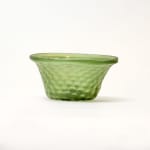Islamic Green Glass Bowl, 900 CE - 1000 CE
Glass
height 5.1 cm
height 2 in
height 2 in
GF.0121
This transluscent green bowl has flared curved walls departing from a slightly kicked, but otherwise flat, base. The rim is straight, and a lip is tooled just below. The decoration...
This transluscent green bowl has flared curved walls departing from a slightly kicked, but otherwise flat, base. The rim is straight, and a lip is tooled just below. The decoration consists of an overall pattern of sunken hexagones forming a honeycomb motif. Such motifs were adopted by Islamic glassmakers who found inspiration in Sassanian decorative prototypes. Since the honeycomb pattern was amongst the most popular and well-known motifs by the end of the ninth century, it was adopted by the metalworkers who prepared the bronze molds for the glassmakers.
The honeycomb motif on cut glas is often cut deeply into the surface of the vessel to create a dramatic contrast between light and shade. In molded glass, on the other hand, the relief is sometimes so subtle that the pattern is barely discernible and easier to see with the aid of the shadow cast by the vessel.
This bowl exemplifies a well-defined use of honeycomb patterns. (LK)
The honeycomb motif on cut glas is often cut deeply into the surface of the vessel to create a dramatic contrast between light and shade. In molded glass, on the other hand, the relief is sometimes so subtle that the pattern is barely discernible and easier to see with the aid of the shadow cast by the vessel.
This bowl exemplifies a well-defined use of honeycomb patterns. (LK)
1
of
31



